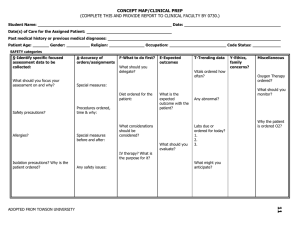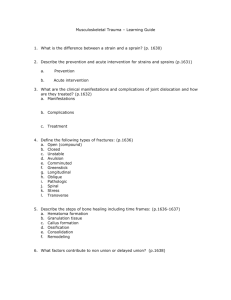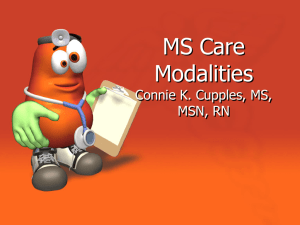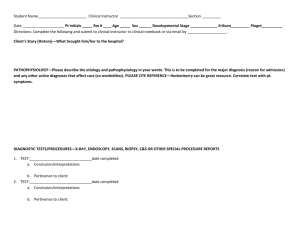File - What you Need to Know
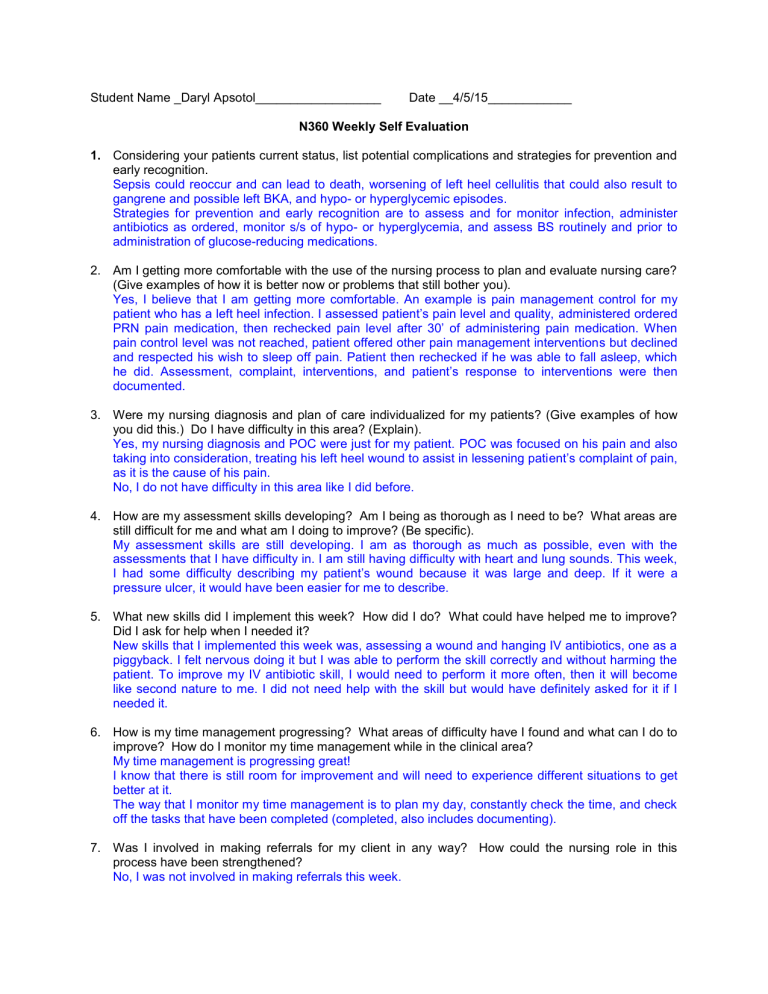
Student Name _Daryl Apsotol__________________ Date __4/5/15____________
N360 Weekly Self Evaluation
1. Considering your patients current status, list potential complications and strategies for prevention and early recognition.
Sepsis could reoccur and can lead to death, worsening of left heel cellulitis that could also result to gangrene and possible left BKA, and hypo- or hyperglycemic episodes.
Strategies for prevention and early recognition are to assess and for monitor infection, administer antibiotics as ordered, monitor s/s of hypo- or hyperglycemia, and assess BS routinely and prior to administration of glucose-reducing medications.
2. Am I getting more comfortable with the use of the nursing process to plan and evaluate nursing care?
(Give examples of how it is better now or problems that still bother you).
Yes, I believe that I am getting more comfortable. An example is pain management control for my patien t who has a left heel infection. I assessed patient’s pain level and quality, administered ordered
PRN pain medication, then rechecked pain level after 30’ of administering pain medication. When pain control level was not reached, patient offered other pain management interventions but declined and respected his wish to sleep off pain. Patient then rechecked if he was able to fall asleep, which he did. Assessment, complaint, interventions, and patient’s response to interventions were then documented.
3. Were my nursing diagnosis and plan of care individualized for my patients? (Give examples of how you did this.) Do I have difficulty in this area? (Explain).
Yes, my nursing diagnosis and POC were just for my patient. POC was focused on his pain and also taking into consideration, treating his left heel wound to assist in lessening pati ent’s complaint of pain, as it is the cause of his pain.
No, I do not have difficulty in this area like I did before.
4. How are my assessment skills developing? Am I being as thorough as I need to be? What areas are still difficult for me and what am I doing to improve? (Be specific).
My assessment skills are still developing. I am as thorough as much as possible, even with the assessments that I have difficulty in. I am still having difficulty with heart and lung sounds. This week,
I had some difficulty d escribing my patient’s wound because it was large and deep. If it were a pressure ulcer, it would have been easier for me to describe.
5. What new skills did I implement this week? How did I do? What could have helped me to improve?
Did I ask for help when I needed it?
New skills that I implemented this week was, assessing a wound and hanging IV antibiotics, one as a piggyback. I felt nervous doing it but I was able to perform the skill correctly and without harming the patient. To improve my IV antibiotic skill, I would need to perform it more often, then it will become like second nature to me. I did not need help with the skill but would have definitely asked for it if I needed it.
6. How is my time management progressing? What areas of difficulty have I found and what can I do to improve? How do I monitor my time management while in the clinical area?
My time management is progressing great!
I know that there is still room for improvement and will need to experience different situations to get better at it.
The way that I monitor my time management is to plan my day, constantly check the time, and check off the tasks that have been completed (completed, also includes documenting).
7. Was I involved in making referrals for my client in any way? How could the nursing role in this process have been strengthened?
No, I was not involved in making referrals this week.
Assessing client’s needs for discharge then speaking with the case manager as to what referrals are available to patient could have strengthened my nursing role in this process.
8. List the specific interventions, in order of priority, for two of your clients and explain how you determined which interventions took precedent.
Client #1-
Low O2 sat- administer supplement O2 and continuous O2 monitoring
Infection- administer ordered antibiotics, monitor for s/s of infection
Wound- Assess, monitor, and administer ordered medications, and provide wound care
Control blood sugar- check BS routinely and administer ordered diabetic medications if needed.
Adequate nutrition- Provide high protein diet as well as diabetes diet
Fall- Since patient has rt BKA, implement fall precaution





